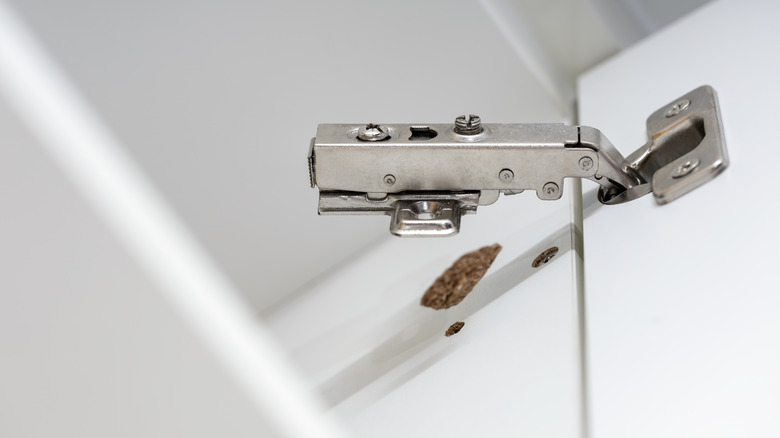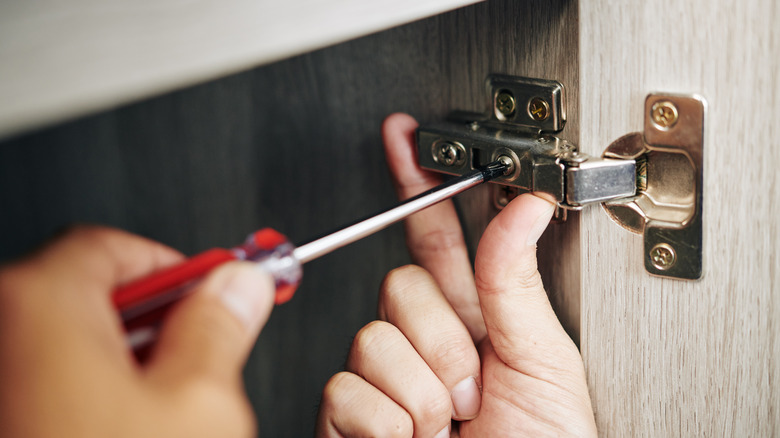Fixing Your Broken Cabinet Hinges Is Easier Than You Think
Modern cabinet hinges can be bewildering to DIY newcomers and old-timers alike. They require special equipment to install, and sometimes even use screws you probably won't see anywhere else. So when your cabinet door is hanging on a prayer after little Suzy decided to ride it from peanut butter to jelly, it's tempting to panic, call in a pro, or just close the door and ignore it. But this problem is usually a quick fix that works exactly like other stripped screws and will often leave you with even stronger cupboard doors. TikTok DIYer @luonthedaily shows you how to fix broken cabinet hinges in just over a minute, but if you dig in just a little deeper you'll be glad you did. (An expert can help you understand different hinges and how they're best used.)
These works of engineering art, once known as Euro or Blum hinges, are so commonplace now they're mostly just called cabinet hinges. At a glance, the defining characteristic of these joints is the large circular cup (they're sometimes called "cup hinges" too), into which the hinge mechanism usually folds when the door is closed. The cup also simplifies installation, and this style of hinge dramatically improves on older styles by being easily adjusted in several directions. But before you worry about that, you need to fix that stripped screw hole.
The basic fix for stripped cupboard hinge screws
There are lots of quick methods for repairing a stripped screw hole, but the best process for cabinet hinge screws is the dowel method described by @luonthedaily. Start by measuring the hole and purchasing a hardwood dowel of the same size (all hardware stores stock these). Now, drill out the hole with a bit that matches the same size as the dowel. Be careful to keep the hole's depth the same. Insert the dowel and mark where it should be cut to be flush with the top of the hole. Cut it with a utility knife or handsaw, then put wood glue in the hole and a little on the dowel before pushing it into the hole. Allow the glue to dry per its package directions, then use a wood screw to reattach the hinge.
Because you're securing a hardwood dowel with wood glue, this fix will be stronger than the original screw if your cabinets are made of a material like medium-density fiberboard (MDF). It might also mean that you can (and should) use a different type of screw to secure the hinge. Cabinet hinges are sometimes installed using confirmat screws, a thicker screw with aggressive threads developed specifically for securing furniture. They are often used with MDF and similar materials and are blunt, meaning they require a large-diameter pilot hole. However, stripped screw holes repaired with dowels only require a standard wood screw.
What if your hinges are broken in some other way?
So far, we've been assuming that your cabinet hinges are broken like @luonthedaily's, with a stripped screw hole. But there are other ways that cup hinges can fail. Perhaps the most common is a cabinet door that's loose because an adjustment screw is missing. Finding a hinge adjustment screw might not be the easiest thing. Ask at your big-box hardware store's cabinetry department. If you have a local fastener retailer like Fastenal, take a screw from one of your other hinges and bring it there — they might be able to track it down. You can also try to contact the hinge's manufacturer. In some cases, you might have to resort to replacing the hinge entirely. You'll have a lot of options in terms of features, like soft closing hinges (though they might not be worth the money).
Needless to say, sometimes people just have loose screws. Adjustment screws tend to loosen over time and will eventually cause your cabinet doors to behave as if they're broken when all they need is some tweaking. It varies from model to model, but Blum-style hinges can usually be adjusted in three directions: in/out, left/right, and up/down. The screws for in/out adjustment are usually found on the hinge's arm or body, while vertical adjustment is often achieved by loosening the hinge mounting plate and moving it up or down.

